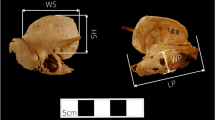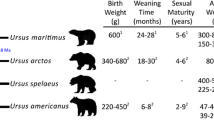Abstract
The age of adult mammals is required for studies related to ontogeny patterns, growth rate, and life history. However, the reliable age determination from skulls with no canine teeth is generally inaccurate. This research aims to develop an age prediction model for adult male sea lions by measures of a particular skull section, which was validated by counting dentine growth layers in their upper canine teeth. We used skulls and teeth of 49 Galapagos sea lions (GSL, Zalophus wollebaeki) aged between 13 and 20 years old collected in different breeding rookeries of the Galapagos archipelago between 2000 and 2018. Two groups of skull measures were considered: (1) measures correlating with total skull length and (2) measures used in growth models in the literature. A generalized additive model was adjusted to estimate ages on skulls. The measures that best described the age prediction model were maxillary tooth row length (MTRL), occipital plate height (OPH), anterior nasal width (ANW), braincase posterior width (BPW), braincase width (BW), jugal supraorbital process height (JSPH), nasal length (NL), orbital length (OL), and postpalate length (PosL) (r2 = 0.93; AIC = 56.16). The predicted ages were close to those counted in teeth with a standard deviation between 0.10 and 0.45 of the average age. This validates the usefulness of our approach to determine age in skulls of GSL even with missing teeth. We recommend the assessment and application of this methodology in morphometric research of pinnipeds but considering morphological characteristics and the skull development of each species.



Similar content being viewed by others
References
Abdala F, Flores DA, Giannini N (2001) Postweaning ontogeny of the skull of Didelphis Albiventris. J Mammal 82:190–200
Audibert P, Drehmer C, Danilewicz D, de Oliveira LR (2017) Do cranial suture age and growth layer groups correlate in south American pinnipeds? J Mar Biol Assoc UK 98:635–644
Bohórquez-Herrera J, Aurioles-Gamboa D, Hernández-Camacho C, Adams D (2017) Variability in the skull morphology of adult male California sea lions and Galapagos Sea lions. In: Alava J (ed) Tropical Pinnipeds: bio-ecology, threats and conservation. CRC Press/ Taylor & Francis Group, Abingdon
Brunner S (1998) Cranial morphometrics of the southern fur seals Arctocephalus forsteri and A. pusillus (Carnivora: Otariidae). Aust J Zool 46:67–108
Brunner S (2004) Fur seals and sea lions (family: Otariidae) identification of species and taxonomic review. Syst Biodivers 1:339–439
Brunner S, Bryden MM, Shaughnessy PD (2004) Cranial ontogeny of otariid seals. Syst Biodivers 2:83–110
Chai Y, Maxson RE (2006) Recent advances in craniofacial morphogenesis. Dev Dynam 235:2353–2375
Cheverud JM (1995) Morphological integration in the saddle-back tamarin (Saguinus fuscicollis) cranium. Am Nat 145:63–89
Crespo EA (1984) Dimorfismo sexual en los dientes caninos y en los cráneos de lobo marino del Sur, Otaria flavescens (Shaw 1800) (Pinnipedia: Otariidae) rev Museo Argentino de Ciencias Naturales. Zoología 13:245–254
Franco-Moreno RA, Cruz-Escalona VH, Aurioles-Gamboa D, Vera-Alfaro P, Salas J, Ravela S (2015) Variability and sexual dimorphism in skull morphometry of California Sea lions (Zalophus californianus) in Mexico. Mamm Biol 80:316–327
Hallgrímsson B, Lieberman DE, Liu W, Ford-Hutchinson AF, Jirik FR (2007) Epigenetic interactions and the structure of the phenotypic variation in the cranium. Evol Dev 9:76–91
Jeglinski J, Müller B, Pörschmann U, Trillmich F (2010) Field-based age estimation of juvenile Galapagos Sea lions (Zalophus wollebaeki) using morphometric measurements. Aquat Mamm 36:262–269
King J (1972) Observations on phocid skulls. In: Functional anatomy of marine mammals. British Museum (Natural History), London, England, pp 81–115
King JC, Gelatt TS, Pitcher KW, Pendleton GW (2007) A field-based method for estimating age in free-ranging Steller Sea lions (Eumetopias jubatus) less than twenty-four months of age. Mar Mamm Sci 23:262–271
Klevezal G (1996) Recording structures of mammals. Determination of age and reconstruction of life history. Mammal Rev 26:188–188
Klingenberg CP (2008) Morphological integration and developmental modularity. Annu Rev Ecol Evol S 39:115–132
Kunc H, Wolf J (2008) Seasonal changes of vocal rates and their relation to territorial status in male Galápagos Sea lions (Zalophus wollebaeki). Ethology 114:381–388
Lieberman DE, Pearson OM, Mowbray KM (2000) Basicranial influence on overall cranial shape. J Human Evol 38:291–315
Maldonado-Orozco JA (1997) Análisis de los parámetros morfológicos Para la determinación de la edad y sexo en el lobo marino californiano (Zalophus californianus californianus). Dissertation. Facultad de Ciencias, Universidad Nacional Autónoma de México, DF, 82 pp
Molina-Schiller D, Pinedo MC (2004) Growth layer patterns in Arctocephalus australis canine teeth: evaluation of techniques for age determination. Lat Am J Aquat Res 3:107–118
Newsome SD, Etnier MA, Monson DH, Fogel ML (2009) Retrospective characterization of ontogenetic shifts in killer whale diets via δ13C and δ15N analysis of teeth. Mar Ecol Prog Ser 374:229–242
Opperman LA, Gakunga PT, Carlson DS (2005) Genetic factors influencing morphogenesis and growth of sutures and synchondroses in the craniofacial complex. Semin Orthod 11:199–208
Orr RT, Schonewald J, Kenyon KW (1970) The California Sea lion: skull growth and a comparison of two populations. Proc Calif Acad Sci Fourth Ser 37:381–394
Orr AJ, Newsome SD, Laake JL, VanBlaricom GR, DeLong RL (2011) Ontogenetic dietary information of the California Sea lion (Zalophus californianus) assessed using stable isotope. Mar Mammal Sci 28:714–732
Páez-Rosas D, Guevara N (2017) Management strategies and conservation status of Galapagos Sea lion populations at San Cristóbal Island, Galapagos, Ecuador. In: Alava J (ed) Tropical Pinnipeds: bio-ecology, threats and conservation. CRC Press/ Taylor, Francis Group, Abingdon
Páez-Rosas D, Aurioles-Gamboa D, Alava JJ, Palacios DM (2012) Stable isotopes indicate differing foraging strategies in two sympatric otariids of the Galapagos Islands. J Exp Mar Biol Ecol 44:424–425
Ravindra K, Rattan P, Mor S, Aggarwal AN (2019) Generalized additive models: building evidence of air pollution, climate change and human health. Environ Int 132:104987 ISSN 0160-4120
Reijnders P, Brasseur S, Van der Toorn J, Van der Wolf O, Boyd I, Harwood J, Lavigne D, Lowry L (1993) Seals, fur seals, sea lions, and walrus. Status survey and conservation plan. IUCN/SSC Seal Specialist Group, Gland, Switzerland
Riedman M (1990) The Pinnipeds: seals, sea lions and walruses. University of California Press, USA
Riofrío-Lazo M, Aurioles-Gamboa D (2013) Timing of isotopic integration in marine mammal skull: comparative study between calcified tissues. Rapid Commun Mass Spectrom 27:1076–1082
Riofrío-Lazo M, Páez-Rosas D (2020). Galapagos Sea lions and fur seals: adaptations to environmental variability. In: ethology and behavioral ecology of eared Seales and the walrus, the Otariids and Odobenid. Campagna C, (Eds). Springer science & business media
Riofrío-Lazo M, Aurioles-Gamboa D, Le Boeuf BJ (2012) Ontogenetic changes in feeding habits of northern elephant seals revealed by δ15N and δ13C analysis of growth layers in teeth. Mar Ecol Prog Ser 450:229–241
Rust L, Danil K, Melin R, Wilkerson B (2019) Accuracy and precision of age determination using growth layer groups for California Sea lions (Zalophus californianus) with known ages. Mar Mam Sci 35:1–14. https://doi.org/10.1111/mms.12605
Sanfelice D, Molina-Schiller D, De Freitas T (2018) Development and growth in skulls of three Otariidae species: a comparative morphometric study. J Mar Biol Assoc UK 98:1801–1815
Silvertsen E (1953) A new species of sea lion, (Zalophus wollebaeki), from Galapagos Islands. The Norwegian zoological expedition to the Galápagos Islands 1925, conducted by Alf wollebaek, XIV. Det Kongelige Norske Videnskabers Selskabs Forhandlinger 599:1–3
Tarnawski BA, Cassini GH, Flores DA (2014) Skull allometry and sexual dimorphism in the ontogeny of the southern elephant seal (Mirounga leonina). Can J Zool 92:19–31
Trillmich F, Meise K, Kalberer S, Mueller B, Piedrahita P, Pörschmann U, Wolf J, Krüger O (2016) On the challenge of interpreting census data: insights from a study of an endangered Pinniped. PLoS One, 11:e0154588. https://doi.org/10.1371/journal.pone.0154588
Vásquez-Cuevas MJG (1993) El cráneo del lobo marino común Zalophus californianus californianus lesson, 1828 (Carnivora: Otariidae) en el Golfo de California. Dissertation. Facultad de Ciencias, Universidad Nacional Autónoma de México, México DF, 180 pp.
Vázquez-Cuevas M, Aguayo-Lobo A, Medrano-González L (2000) El desarrollo del cráneo del lobo marino de California (Zalophus californianus californianus). Cienc Mar 26:145–176
Webster D, Webster M (1974) Comparative vertebrate morphology. Academic Press, New York
Wolf JB, Tautz D, Trillmich F (2007) Galápagos and Californian sea lions are separate species: genetic analysis of the genus Zalophus and its implications for conservation management. Front Zool 4:20
Wood S (2017) Generalized Additive Models New York: Chapman and Hall/CRC 10 1201/9781315370279
Acknowledgments
We thank the Galapagos National Park Directorate (GNPD) for providing logistical support and for granting us permission to collect the samples used in this study. We also thank the Universidad San Francisco de Quito (USFQ) for logistical support during the preparation of this manuscript. We are grateful to GNPD rangers and the crew “Sierra Negra” ship for their help in collecting and processing the biological material used in this study. We offer special gratitude to all members of GNPD/USFQ/UNC research expeditions for providing their invaluable work during the collection of osteological material. Finally, we thank Dr. Carlos F. Mena and all staff of Galapagos Science Center (GSC) for providing the facilities for information processing and samples analysis.
Funding
Financial support was provided by the Universidad San Francisco de Quito (USFQ).
Author information
Authors and Affiliations
Contributions
Conceptualization: S.I-B. and D.P-R. Collected data: S-I-B., J.T. and D.P-R. Designed methodology: D.O.U., D.P-R. and M.R-L. Funding acquisition: D.P-R. Formal analysis: D.O.U., D.P-R., and M.R-L. Writing-original draft: S.I-B. and D.P-R. Writing-review and editing: S.I-B., D.O.U., J.T., M.R-L. and D.P-R. All authors gave final approval for publication.
Corresponding author
Additional information
Communicated by: Cino Pertoldi
Publisher’s note
Springer Nature remains neutral with regard to jurisdictional claims in published maps and institutional affiliations.
Rights and permissions
About this article
Cite this article
Izurieta-Benítez, S., Urquía, D.O., Torres, J. et al. Age prediction model for adult male Galapagos sea lions based on skull measures. Mamm Res 66, 201–210 (2021). https://doi.org/10.1007/s13364-020-00553-4
Received:
Accepted:
Published:
Issue Date:
DOI: https://doi.org/10.1007/s13364-020-00553-4




